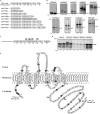Detection of nonstructural protein 6 in murine coronavirus-infected cells and analysis of the transmembrane topology by using bioinformatics and molecular approaches
- PMID: 19386712
- PMCID: PMC2698535
- DOI: 10.1128/JVI.00254-09
Detection of nonstructural protein 6 in murine coronavirus-infected cells and analysis of the transmembrane topology by using bioinformatics and molecular approaches
Abstract
Coronaviruses encode large replicase polyproteins which are proteolytically processed by viral proteases to generate mature nonstructural proteins (nsps) that form the viral replication complex. Mouse hepatitis virus (MHV) replicase products nsp3, nsp4, and nsp6 are predicted to act as membrane anchors during assembly of the viral replication complexes. We report the first antibody-mediated Western blot detection of nsp6 from MHV-infected cells. The nsp6-specific peptide antiserum detected the replicase intermediate p150 (nsp4 to nsp11) and two nsp6 products of approximately 23 and 25 kDa. Analysis of nsp6 transmembrane topology revealed six membrane-spanning segments and a conserved hydrophobic domain in the C-terminal cytosolic tail.
Figures




References
-
- Angeles Juanes, M., J. C. Igual, and M. C. Bano. 2008. Membrane topology and post-translational modification of the Saccharomyces cerevisiae essential protein Rot1. Yeast 2593-106. - PubMed
-
- Baker, S. C., and M. R. Denison. 2008. Cell biology of nidovirus replication complexes, p. 103-113. In S. Perlman, T. Gallagher, and E. J. Snijder (ed.), Nidoviruses. ASM Press, Washington, DC.
Publication types
MeSH terms
Substances
Grants and funding
LinkOut - more resources
Full Text Sources

